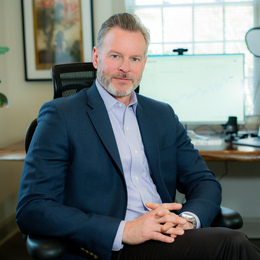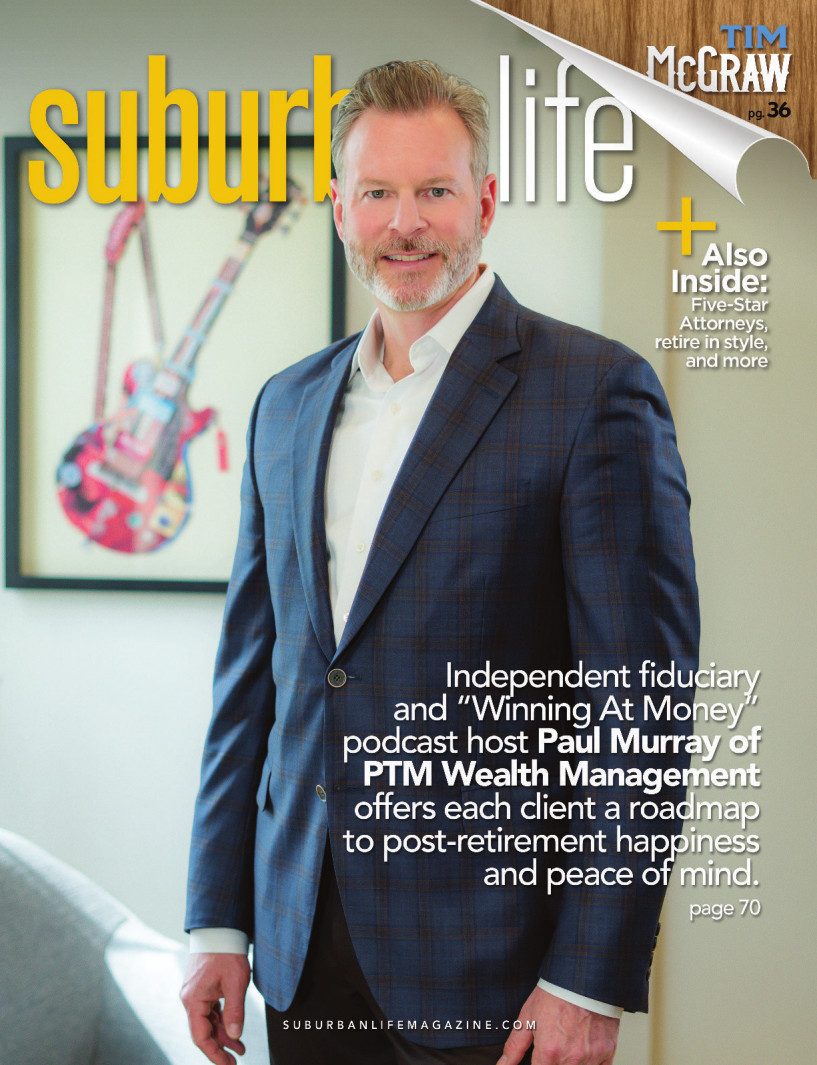
The Four Ways to Win at Retirement
Independent fiduciary and “Winning At Money” podcast host Paul Murray of PTM Wealth Management offers each client a roadmap to post-retirement happiness and peace of mind.
In 2011, Paul Murray decided to launch his own financial advisory company after more than a decade at a traditional, Wall Street-style brokerage firms. His reason: He wanted to give investors an alternative to a retirement planning model he considered outdated.
His firm, PTM Wealth Management, offers a comprehensive approach that puts the client first, working toward a happy retirement centered around their favorite activities instead of concerns about where their money is going to come from. As an independent fiduciary, his approach represents a marked difference from those who ask clients to pay more even though they may be receiving less in terms of sound advice and cost-effective strategies.
“Most other advisors aren’t able to do the in-depth, holistic financial planning, which includes tax planning, and they’re not fiduciaries,” Murray says. “They may have inherent conflicts, and they’re not technically working under the definition of a fiduciary advisor as defined by the Securities and Exchange Commission.
“Fiduciary is a bit of a buzzword in the industry these days,” he continues. “Investors are becoming accustomed to looking for and asking if an advisor is a fiduciary because they recognize the importance of somebody who acts in the best interests in all areas of financial advice.”
PTM Wealth Management provides a breadth of knowledge in regard to financial planning, tax strategies, investment management, insurance services, and estate and charitable planning. Murray has honed his skills as a communicator by teaching retirement courses at local universities, and his interactions with clients are appreciated because of his easy to understand and straightforward style.
As an Accredited Investment Fiduciary and Chartered Financial Consultant, Murray has developed an approach steeped in financial planning. Based on his experience, he has identified four crucial ways in which people can “win” at retirement.
1. Be aware of rising tax rates.
Murray believes that a common mistake made by investors—as well as their financial advisors—is to overlook the implications of federal taxes on retirement income. This can result in less real after-tax income as taxes inevitably rise to address our rising national debt, and coming Medicare and Social Security insolvencies in 2026 and 2033.
Murray believes that a common mistake made by investors—as well as their financial advisors—is to overlook the implications of federal taxes on retirement income. This can result in less real after-tax income as taxes inevitably rise to address our rising national debt, and coming Medicare and Social Security insolvencies in 2026 and 2033.
“I’ve been providing financial advice to private clients for more than 20 years,” he says. “My observations, stemming from conversations with my peers in the industry, is that they are really focusing primarily on investment returns and investment planning, and they’re kind of missing the elephant in the room: It really doesn’t matter how much you save; it only matters how much you’ll have after taxes. Taxes are on the rise, and if you’re not planning to insulate yourself from those tax increases in retirement, you’re leaving yourself open to having a less than successful retirement.”
Most taxpayers are unaware that tax rates will be increasing in 2026 by order of the Tax Cuts and Jobs Act of 2017, resulting in a 3 percent to 4 percent hike for middle- and upper-middle-class taxpayers,” Murray says.
Throw in the ballooning national debt, and the reliance on tax dollars to keep Medicare and Social Security going, and it is vital to protect after-tax retirement income. To address this this risk of rising taxes, PTM Wealth Management has developed the Guided Roth Conversion Program™ to help clients reduce or eliminate taxes in retirement by transferring taxes from forever-taxable IRAs and 401(k)s to never-taxable Roth IRAs.
2. Protect yourself from bad markets.
Murray has been in the industry through two major financial crises—the bursting of the dot-com bubble of 2000 to 2002 and the Great Financial Crisis of 2007 to 2009—and says the next one is inevitable; the only unknown is when it will happen. With that in mind, he urges clients to determine what portion of their portfolio they do not feel comfortable losing in the markets, and to consider principal protection products that can insulate them from declines in the markets.
Murray has been in the industry through two major financial crises—the bursting of the dot-com bubble of 2000 to 2002 and the Great Financial Crisis of 2007 to 2009—and says the next one is inevitable; the only unknown is when it will happen. With that in mind, he urges clients to determine what portion of their portfolio they do not feel comfortable losing in the markets, and to consider principal protection products that can insulate them from declines in the markets.
“The way you avoid losing a large percentage of your savings in the next financial crisis is to first evaluate how you feel about losing money and then understand how big losses can impact your financial future,” he says. “We give all of our clients a risk questionnaire and analyze their existing investments using a platform that shows how they are likely to perform in the next crisis. What we find is there’s often a big disconnect. People think that they’re conservative, but how they’re investing is the complete opposite, and what they’re doing is setting themselves up for a major setback when we have the next financial crisis. We match their tolerance for losing money to one of our risk-managed models that may also include principal-protected investments. We want to find the right balance of growth and principal protection for each of our clients.”
3. The cost of financial advice matters—a lot.
Murray often comes across individuals who are wary about using a financial advisor because of the fees associated with the service. He agrees that cost should be a significant factor in choosing an advisor. At many of the larger firms, expensive mutual funds are often being used, and the price tag for financial advice is high—an average of more than 1 percent for the assets these firms manage—but the client does not even receive comprehensive financial planning or tax planning.
Murray often comes across individuals who are wary about using a financial advisor because of the fees associated with the service. He agrees that cost should be a significant factor in choosing an advisor. At many of the larger firms, expensive mutual funds are often being used, and the price tag for financial advice is high—an average of more than 1 percent for the assets these firms manage—but the client does not even receive comprehensive financial planning or tax planning.
“As independent fiduciaries, we have a different psychology,” he says. “We believe that investing in index funds and low-cost investment strategies means our clients get to keep more of their money in the market for their benefit. And our highest fee is less than the standard 1 percent or more of assets under management. By lowering investment and financial advisory costs, our clients are potentially able to build bigger tax-advantaged savings.”
4. Be prepared for long-term care.
With people often living into their 80s, 90s, and beyond, the need for long-term care has risen dramatically. The costs associated with such care have seen sharp increases, too.
With people often living into their 80s, 90s, and beyond, the need for long-term care has risen dramatically. The costs associated with such care have seen sharp increases, too.
“Believe it or not, among all the risks that threaten a successful retirement, long-term care is probably the single biggest risk because the sheer cost of long-term care is so exorbitant,” Murray says. “There are a couple of places you don’t want your money to go when you die. The first place is the federal government, in the form of taxes paid by your heirs, and the second place is the nursing home.”
Murray encourages clients in their 50s and 60s to give serious thought to planning for the need for long-term care. A beneficial strategy may include modern life policies, which include significant indemnity payments for long-term care.
“In these policies, there is no reimbursement of your payment for care,” Murray says. “If you qualify for long-term care, the policies simply send you your monthly benefits. And if you die peacefully in your sleep, your heirs receive a tax-free death benefit.
“I consider long-term care planning to be a big issue in retirement, and in order to win at retirement you’re going to have to focus on it,” he continues. “There have been a lot of innovations in the industry, and I think it’s important for people to evaluate what their options are. A failure to do so might mean passing more of their wealth on to the nursing home instead of the people they love.”
PTM Wealth Management, LLC
1501 Lower State Road, Building D, Suite 206
North Wales, PA 19454
(267) 317-1515
PTMWealth.com
1501 Lower State Road, Building D, Suite 206
North Wales, PA 19454
(267) 317-1515
PTMWealth.com
Photograph by Jody Robinson
Published (and copyrighted) in Suburban Life magazine, July 2022.



